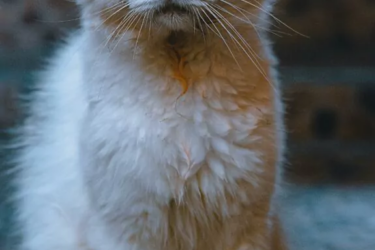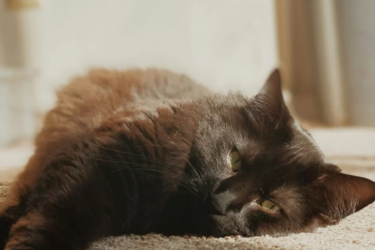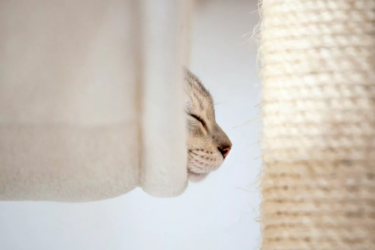
Are you looking for a sweet and breathtakingly beautiful pedigree cat? Then the Turkish Angora is definitely for you! This breed is very social and looks like it came straight out of a fairy tale. Want to know more? Keep reading!
In this blog:
- What is the personality of a Turkish Angora cat?
- What does a Turkish Angora look like?
- How to care for a Turkish Angora?
- How long does a Turkish Angora live?
- The health of a Turkish Angora cat
- The origin of the Turkish Angora
- How much does a Turkish Angora cost?
And we will also tell you:
- How big does a Turkish Angora get?
- How much does a Turkish Angora cost?
- Which cats live the longest?
1. What is the personality of a Turkish Angora cat?
Turkish Angoras are beautiful. But they are also incredibly sweet and fun! These pedigree cats are playful, curious, and place great importance on forming a close bond with their owners. They go out of their way to do so. Furthermore, they are very intelligent and often approach problems in a problem-solving manner – a Turkish Angora always finds a way to, for example, open a cabinet. They also know exactly where their favorite treats are stored. They can even swim and love water – so don’t be surprised if a Turkish Angora steps into the shower with you!
They also love talking with their fellow cats and with their owners. Turkish Angoras meow but can also make cute high-pitched chirping sounds. They enjoy making contact, and you’ll notice this as an owner because the cat is always with you – whether you’re cooking, working, or lounging on the couch. A Turkish Angora is always nearby!
Turkish Angoras are playful. Therefore, always spoil them with a challenging cat tree!
2. What does a Turkish Angora look like?
As mentioned earlier: Turkish Angoras are beautiful. Almost magically beautiful with their stunning tail and long fur. And their fur can come in various colors. Most Angoras are white. But they can also appear in black, tabby, red, blue, lavender, cinnamon, and tabby-white. Smoked and pointed variants also exist – meaning that the fur at the ends of the ears, tail, and paws, for example, is a different color.
The eyes of the Turkish Angora can also be different colors. Blue is the most common (especially in combination with a white coat), but green, yellow, gold, and amber eyes are also seen.
The body of these cats is strong and elegant. Turkish Angoras are of average size, with males weighing between 5 and 7 kilograms. Females are a bit smaller, usually weighing between 3 and 5 kilograms. The ears are large, the legs are slender, the paws are small, and the tail is beautifully long. The head is V-shaped, and the eyes are set high on the head.
3. Everything about caring for a Turkish Angora
This breed has medium-length fur without an undercoat. This means that the fur of Turkish Angoras requires less intensive care than the fur of long-haired cats with an undercoat. Matting or felting is rare in Turkish Angoras. However, grooming is still important – make sure to comb or brush the cat at least once, but preferably twice a week, with a fine comb or a smooth brush.
Additionally, a Turkish Angora requires the same good care as any other cat:
- Lots of love and attention
- A safe home with comfortable cat beds
- A suitable cat tree
- Care when ill
- A sitter when you go on vacation
- Healthy food and fresh water every day
- Clean litter boxes with good litter
- Cat toys
- Treatments for fleas and other parasites
- Regular vet check-ups

4. How long does a Turkish Angora live?
A Turkish Angora cat can live between 12 and 18 years. They are quite healthy cats with few particular conditions. So, if you take good care of this breed, you can enjoy their company for a long time!
5. The health of a Turkish Angora cat
Pedigree cats are bred for unique characteristics. The Turkish Angora also has traits that make it special, such as:
- Long fur (mainly white, but other colors are also present)
- Medium-sized
- Strong and elegant body
Do you think a Turkish Angora is the right fit for you? Then make sure to thoroughly research the health of this breed. Many pedigree cats are prone to hereditary conditions. For example, Turkish Angora cats with white fur and blue eyes are more susceptible to deafness. It’s important to be aware of this.
If you want to bring a healthy cat into your home, ask advice from a veterinarian. You can also consult the websites of Dier & Recht and the Netherlands Food and Consumer Product Safety Authority, where you’ll find information on the breed’s health, whether it is allowed, and what rules apply to breeders.
Always buy a Turkish Angora from a reputable breeder, preferably one affiliated with a breed association. This way, you can be sure the cat is healthy and well-cared for. Also, ask the breeder for a health certificate or guarantee for extra assurance.
Now, you know almost everything about the Turkish Angora. But we haven’t told you yet about the origin of this beautiful breed. Curious about where the Turkish Angora comes from? Keep reading!
6. The origin of the Turkish Angora
The story of the origin of the Turkish Angora is quite mysterious. Where they truly come from remains uncertain, but their “roots” lie in Anatolia, which is now Turkey. It is said that these beautiful cats were brought to Europe by Crusaders and quickly became popular among cat breed enthusiasts. The breed was officially recognized in the 17th century but was at risk of disappearing in the 20th century. However, thanks to a group of enthusiastic breeders, the breed survived, and the Turkish Angora remains one of the most beautiful cats in Europe today.
7. How much does a Turkish Angora cost?
Do you want to buy a Turkish Angora cat? Then go to a certified breeder, preferably one affiliated with a breed association. This way, you can be sure you are buying a healthy, well-socialized cat that has been bred in a humane manner. Always ask for the papers, a health certificate, and check the kitten’s parents. Also, take a look at their living conditions: is it clean and homely, and are the parents present? That is a good sign. Do not buy cats through platforms like Marktplaats, eBay, or from unethical breeders.
A Turkish Angora from a good breeder costs around 800 euros. If you’re looking for a cat, but it doesn’t have to be a pedigree, consider checking shelters or adoption agencies. Many loving cats are waiting for a nice home there.
And remember: you’re not getting a cat for a short time, but for its entire life. Are you willing to take good care of the animal and set aside money for its care and vet visits? If so, the Turkish Angora could become your new best friend!
Discover here what the approximate cost of caring for a cat entails
The Turkish Angora in a nutshell:
- The Turkish Angora is generally a healthy cat.
- A Turkish Angora cat can live between 12 to 18 years.
- The coat of a Turkish Angora is medium-long and very beautiful.
- Turkish Angoras can have two different colored eyes.
- A Turkish Angora kitten costs about 800 euros.
- Turkish Angoras are smart, problem-solving, and love their owners.
- A Turkish Angora sheds, just like any other type of cat.
Read more about the smart and active Ocicat
Disclaimer: Petrebels is not a veterinarian or behavior expert. All content, information, and tips on this blog are intended to inspire and are for informational purposes. If your cat has issues or problems, and you are unsure about your cat’s health, always consult a veterinarian or behavior specialist.


